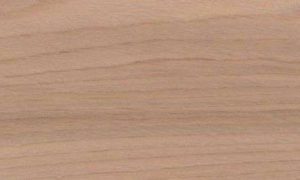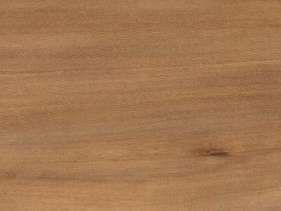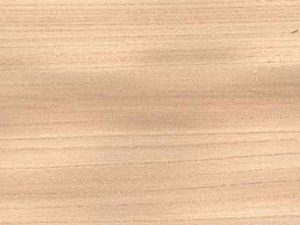Scientific Name
Ulmus americana
Trade Name
Soft elm
Family Name



Common Names
American elm, Elm, Florida elm, Soft elm, Swamp elm, Water elm, White elm
Regions of Distribution
North America
Countries of Distribution [VIEW MAP]
Canada, United States
Common Uses
Baskets, Boxes and crates, Building materials, Casks, Cooperages, Decorative plywood, Decorative veneer, Farm vehicles, Figured veneer, Food containers, Interior construction, Interior trim, Machinery parts, Millwork, Moldings, Packing cases, Pallets, Plywood, Skids, Trimming, Vehicle parts, Veneer, Wainscotting, Wheels
Environmental Profile
| Abundant/Secure | ||||||||||||
| Some long-term concern for the species | ||||||||||||
| May be rare in some parts of its range | ||||||||||||
| Extinct, Endangered, Vulnerable, or Rare within its range | ||||||||||||
| Considered vulnerable in its natural habitat because its numbers are threatened by serious adverse factors throughout its range. However, the species likely exists today in relatively large numbers. |
Distribution Overview
The growth range of American elm extends from southeastern Saskatchewan east to Cape Breton Island, south to central Florida, and west to central Texas. It is also widely planted in western United States, beyond its native eastern range. reported to grow in mixed hardwood forests, and prefers moist soils, particularly in valleys and flood plains.
Heartwood Color
| Brown | ||||||||||||
| Red | ||||||||||||
| Reddish brown | ||||||||||||
| Light brown | ||||||||||||
| Golden brown with a reddish cast | ||||||||||||
| Brown |
Sapwood Color
| Red | ||||||||||||
| Brown | ||||||||||||
| Grey | ||||||||||||
| Brownish white |
Grain
| Even | ||||||||||||
| Interlocked | ||||||||||||
| Straight |
| Straight | ||||||||||||
| Occasionally interlocked, but not always |
Texture
| Fine | ||||||||||||
| Medium | ||||||||||||
| Woolly | ||||||||||||
| Coarse |
Natural Durability
| Perishable | ||||||||||||
| Non-durable | ||||||||||||
| Durable | ||||||||||||
| Very little natural resistance |
Susceptible to attack by wood borers, and Dutch elm disease
Odor
| Has an odor | ||||||||||||
| No specific smell or taste |
Kiln Schedules
| T6 – D4 (4/4) US | ||||||||||||
| T5 – D3 (8/4)US |
Drying Defects
| Checking | ||||||||||||
| Distortion | ||||||||||||
| Warping can be expected | ||||||||||||
| Ring failure |
Ease of Drying
| Thick Stock Requires Care | ||||||||||||
| Medium to High Shrinkage | ||||||||||||
| Moderately Difficult to Difficult | ||||||||||||
| Little degrade | ||||||||||||
| Requires slow and careful seasoning to prevent degrade. |
Tree Size
| Tree height is 10-20 m | ||||||||||||
| Tree height is 20-30 m |
Product Sources
The Lake States in the United States are reported to have the best Elm stands, but the species is also distributed throughout the eastern part of the country. The timber is readily available from commercial dealers, and is priced in the moderate range.
Certified Source
| Certified Source |
Substitutes
Keyaki (Zelkova serrata)
Blunting Effect
| Moderate | ||||||||||||
| Blunting effect on machining is moderate |
Cutting Resistance
| Fairly Difficult to Very Difficult to saw |
Cutting resistance is rather small if edges are kept sharp. Sawn surfaces are often woolly
Gluing
| Fair to Good Results | ||||||||||||
| Fairly Easy to Very Easy | ||||||||||||
| Good properties |
Movement in Service
| Fair to Good Stability – Medium Movement | ||||||||||||
| Moderate dimensional stability after seasoning | ||||||||||||
| Medium |
Nailing
| Fair to Good Results | ||||||||||||
| Fairly Easy to Very Easy | ||||||||||||
| Good nailing properties |
Planing
| Fair to Good Results | ||||||||||||
| Fairly Difficult to Very Difficult | ||||||||||||
| Woolly |
Reported to respond to sharp and thin cutting edges to produce a clean and smooth finish
Resistance to Impregnation
| Resistant heartwood | ||||||||||||
| Resistant sapwood | ||||||||||||
| Sapwood is permeable | ||||||||||||
| Heartwood is moderately resistant |
Response to Hand Tools
| Fairly Difficult to Difficult to Work | ||||||||||||
| Good | ||||||||||||
| Cutting edges should be kept sharp to prevent torn rays |
Screwing
| Fair to Good Results | ||||||||||||
| Fairly Easy to Very Easy | ||||||||||||
| Good screwing properties |
Steam Bending
| Very Good to Excellent Results | ||||||||||||
| Fairly Easy to Very Easy |
The wood has good steam bending properties
Polishing
| High finish |
Staining
| Fair to Good Results | ||||||||||||
| Fairly Easy to Very Easy | ||||||||||||
| Very Good to Excellent Results | ||||||||||||
| Stains well |
Varnishing
| Fair to Good Results | ||||||||||||
| Fairly Easy to Very Easy |
Strength Properties
| Max. crushing strength = low | ||||||||||||
| Bending strength (MOR) = high |
Can be used as a substitute for rock elm
Numerical Data
| Item | Green | Dry | English |
| Bending Strength | 7056 | 11662 | psi |
| Crushing Strength | 431 | 769 | psi |
| Hardness | 813 | lbs | |
| Impact Strength | 49 | 49 | inches |
| Maximum Crushing Strength | 2876 | 5370 | psi |
| Shearing Strength | 1480 | psi | |
| Static Bending | 3332 | 5880 | psi |
| Stiffness | 1093 | 1401 | 1000 psi |
| Work to Maximum Load | 14 | 16 | inch-lbs/in3 |
| Specific Gravity | 0.48 | 0.54 | |
| Weight | 55 | 35 | lbs/ft3 |
| Radial Shrinkage | 4 | % | |
| Tangential Shrinkage | 8 | % | |
| Volumetric Shrinkage | 15 | % | |
| Item | Green | Dry | Metric |
| Bending Strength | 496 | 819 | kg/cm2 |
| Crushing Strength | 30 | 54 | kg/cm2 |
| Hardness | 368 | kg | |
| Impact Strength | 124 | 124 | cm |
| Maximum Crushing Strength | 202 | 377 | kg/cm2 |
| Shearing Strength | 104 | kg/cm2 | |
| Static Bending | 234 | 413 | kg/cm2 |
| Stiffness | 76 | 98 | 1000 kg/cm2 |
| Work to Maximum Load | 0.98 | 1.12 | cm-kg/cm3 |
| Specific Gravity | 0.48 | 0.54 | |
| Weight | 881 | 560 | kg/m3 |
| Radial Shrinkage | 4 | % | |
| Tangential Shrinkage | 8 | % |
References
Boone, R.S., C.J. Kozlik, P.J. Bois and E.M. Wengert. 1988. Dry Kiln Schedules for Commercial Woods: Temperate and Tropical. United States Department of Agriculture, Forest Service, Forest Products Laboratory, General Technical Report FPL-GTR-57, Madison, Wisconsin.
California Department of Forestry. Comparative Physical & Mechanical Properties of Western & Eastern Hardwoods. Prepared by Forest Products Laboratory, University of California at Berkeley, Berkeley, California. n/d.
Canadian Forestry Service. 1981. Canadian Woods – Their Properties and Uses. Third Edition. E.J. Mullins and T.S. McKnight, Editors. Published by University of Toronto Press, Toronto, Canada.
HMSO, 1981. Handbook of Hardwoods, 2nd Edition. Revised by R.H. Farmer. Department of the Environment, Building Research Establishment, Princes Risborough Laboratory, Princes Risborough, Aylesbury, Buckinghamshire.
Jackson, A. and D. Day. 1991. Good Wood Handbook – The Woodworker’s Guide to Identifying, Selecting and Using the Right Wood. Betterway Publications, Cincinnati, Ohio.
Jackson, A. and D. Day. 1991. Good Wood Handbook – The Woodworker’s Guide to Identifying, Selecting and Using the Right Wood. HarperCollins Publishers, London.
Kaiser, J. 1989. Wood of the Month – Elm: An American Favorite Suffers from an Imported Disease. Wood of the Month Annual, Volume 1, Supplement to Wood and Wood Products. Pg. 31-32.
Kline, M. 1985. Ulmus americana – American elm. In A Guide to Useful Woods of the World. Flynn Jr., J.H., Editor. King Philip Publishing Co., Portland, Maine. 1994. Page 355-356.
Lincoln, W.A. World Woods in Color. Linden Publishing Co. Inc, Fresno, California.
Little, E.L. 1980. The Audobon Society Field Guide to North American Trees – Western Region. Published by Arthur A. Knopf, New York.
Panshin, A.J. and C. deZeeuw. 1980. Textbook of Wood Technology, 4th Edition. McGraw-Hill Series in Forest Resources. McGraw-Hill Book Company, New York.
Rendle, B.J. Editor. 1969. World Timbers, Volume Two – North & South America (Including Central America and the West Indies). Published by Ernest Benn Limited, Bouverie House, Fleet Street, London.
USDA. 1987. Wood Handbook – Wood as an Engineering Material, Forest Service, Agriculture Handbook No. 72, Forest Products Laboratory, Madison, Wisconsin.
USDA. 1988. Dry Kiln Operators Manual, Preliminary Copy. Forest Service, Forest Products Laboratory, Madison, Wisconsin.